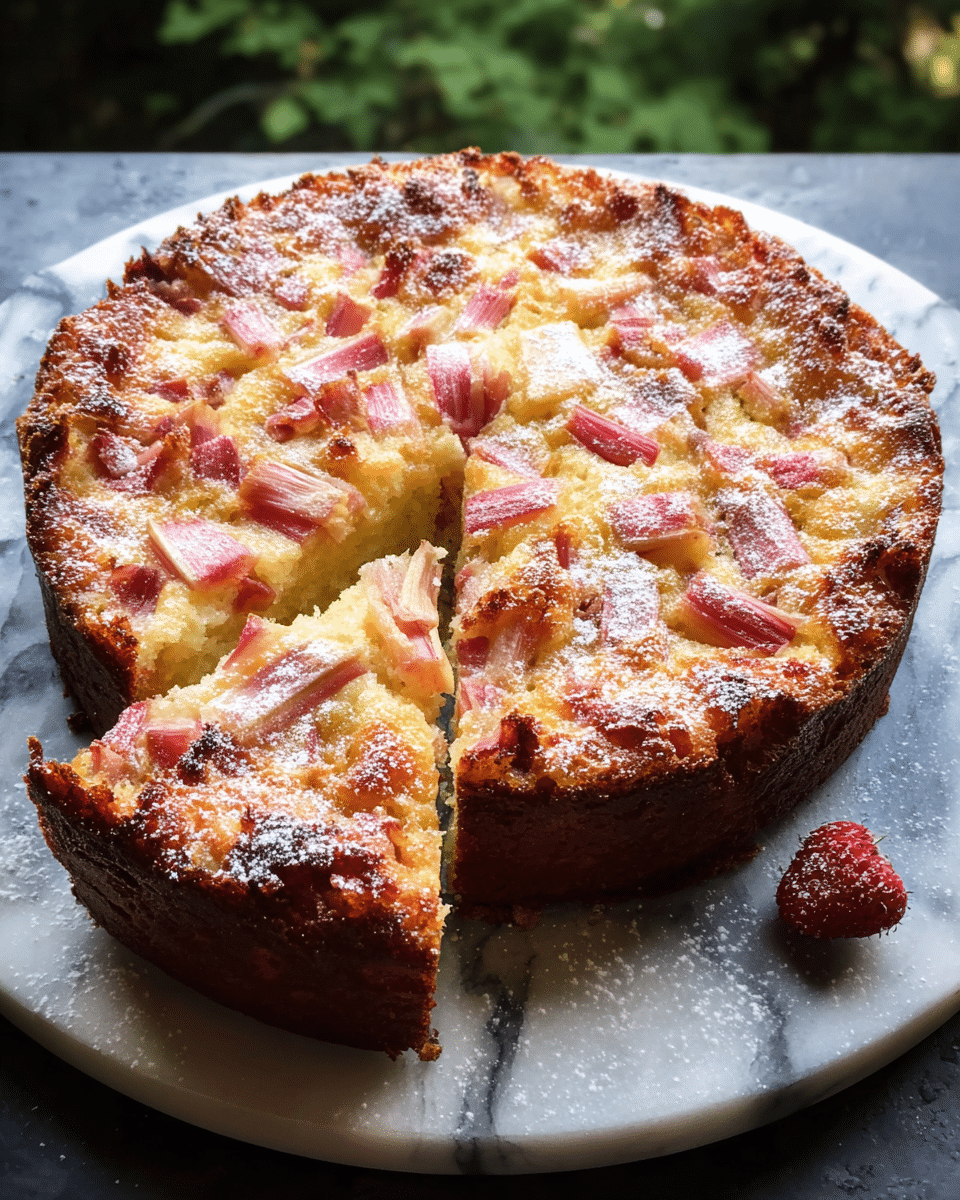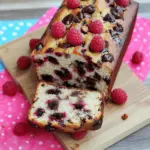The Rhubarb Ricotta Cake is where rustic comfort meets Italian elegance. Whole milk ricotta gives this cake a unique, velvety texture that’s somewhere between a sponge cake and a cheesecake. With tender chunks of rhubarb creating tart surprises in every bite, it’s a lovely reminder of spring’s finest offerings.
Perfect for special brunches, afternoon coffee moments, or dessert at a garden party, this cake is refreshingly light yet indulgent. It keeps beautifully for days, becoming even more flavorful as the ricotta melds with the fruit. Whether you top it with powdered sugar or a spoonful of whipped cream, this cake is bound to impress.
Full Recipe:
Ingredients:
For the Cake:
-
½ cup unsalted butter, room temperature
-
1 cup granulated sugar
-
3 large eggs, room temperature
-
1 cup whole milk ricotta cheese
-
1 teaspoon vanilla extract
-
Zest of 1 lemon (optional, but recommended)
-
1½ cups all-purpose flour
-
2 teaspoons baking powder
-
½ teaspoon salt
For the Rhubarb:
-
2 cups fresh rhubarb, cut into ¾-inch chunks
-
1 tablespoon all-purpose flour (for tossing)
For Finishing:
-
Powdered sugar for dusting
-
Fresh berries for garnish (optional)
Directions:
-
Preheat oven to 350°F (175°C). Grease a 9-inch springform or round cake pan and line with parchment paper.
-
If ricotta is watery, strain it through a fine mesh sieve for 30 minutes.
-
Wash rhubarb, trim ends, and cut into chunky ¾-inch pieces. Toss with 1 tablespoon flour and set aside.
-
In a large bowl, cream butter and sugar until pale and fluffy (about 4 minutes).
-
Add eggs one at a time, beating well after each.
-
Gradually beat in the ricotta to avoid lumps. Stir in vanilla and lemon zest.
-
In a separate bowl, whisk flour, baking powder, and salt.
-
Gently fold the dry mixture into the wet ingredients until just combined—do not overmix.
-
Fold in the floured rhubarb pieces evenly.
-
Pour batter into prepared pan. Shake gently to level the surface.
-
Bake for 45–50 minutes, until golden on top and the center barely jiggles.
-
Let cool completely before removing from pan. Dust with powdered sugar and garnish with fresh berries if desired.
Prep Time: 20 minutes | Cooking Time: 50 minutes | Total Time: 1 hour 10 minutes
Kcal: ~290 kcal per slice | Servings: 10–12 slices
Rhubarb Ricotta Cake: A Taste of Italian Spring in Every Slice
There are desserts that charm the palate, and then there are those that enchant the soul. The Rhubarb Ricotta Cake is firmly in the latter category a perfect symphony of creamy richness and tart brightness that feels both rustic and refined. Inspired by Italian baking traditions and seasonal spring flavors, this cake offers a tender crumb and an airy texture with just the right balance of sweet and sour. Whether served at a brunch, a dinner party, or enjoyed quietly with coffee, this dessert leaves a lasting impression that’s equal parts comfort and elegance.
But what makes this cake so special? To understand its magic, we must dive deeper into its unique ingredients, cultural heritage, and the mindful baking techniques that elevate it beyond the realm of your average fruit cake.
The Heart of the Cake: Ricotta
At the core of this cake lies ricotta a soft, fresh cheese that has long been a staple in Italian kitchens. While most people are familiar with ricotta in savory applications like lasagna or stuffed shells, its versatility in sweet dishes is often underrated.
In baking, ricotta brings an unbeatable moistness and a light, slightly tangy profile that pairs well with both bold and subtle flavors. Unlike heavier cheeses used in cheesecakes, ricotta adds structure without density. It results in a cake that is almost custardy in texture yet still holds its crumb like a traditional sponge.
Good quality ricotta is essential. Whole milk ricotta, ideally from the deli or a specialty shop, yields the best results. Its rich creaminess integrates seamlessly into the batter, providing body without heaviness. Many seasoned bakers recommend draining ricotta beforehand to remove excess moisture, ensuring a consistent texture and avoiding sogginess.
Why Rhubarb?
Rhubarb is a unique ingredient technically a vegetable, often treated like a fruit, and unmistakably tart. Its bright, assertive flavor makes it the perfect counterpart to the creamy mildness of ricotta. When baked into a cake, rhubarb softens and becomes tender, releasing its juices into the surrounding crumb and offering bursts of tanginess with each bite.
Visually, rhubarb also brings a beautiful element to the cake. Its streaks of crimson or blush pink create a mosaic within the pale yellow of the ricotta cake, making each slice look like a work of art. While red rhubarb is often more visually appealing, green-stalk varieties are just as flavorful.
The inclusion of rhubarb aligns perfectly with seasonal spring baking. In many regions, rhubarb is among the first fresh produce to appear after winter, symbolizing renewal and the start of lighter, brighter fare. Incorporating rhubarb into this cake not only ties it to the season but enhances its identity as a celebration dessert light enough for warm days, yet indulgent enough for special occasions.
A Perfect Balancing Act
The Rhubarb Ricotta Cake is a study in contrasts that harmonize:
-
Tart vs. Creamy: The assertiveness of rhubarb offsets the smooth richness of ricotta.
-
Moist vs. Fluffy: Ricotta’s high moisture content creates a cake that stays tender for days without becoming dense.
-
Rustic vs. Elegant: While the cake itself is simple to make, its flavor and texture profile feel elevated, suitable for both a casual picnic and an upscale dessert table.
These contrasts are not incidental they are intentional. The recipe works because it capitalizes on the natural strengths of each ingredient. Where one brings sharpness, the other tempers. Where one offers richness, the other provides lift. It’s this synergy that keeps people coming back for slice after slice.
Baking Wisdom: Tips from the Kitchen
Even though this cake is relatively simple to prepare, certain techniques can make a meaningful difference in the final outcome:
-
Room Temperature Ingredients: This is not optional cold eggs or ricotta can cause the batter to curdle or resist blending. Ensuring all components are at room temperature helps the batter emulsify smoothly.
-
Don’t Overmix: Once the dry ingredients are introduced, fold them gently into the wet mixture. Overmixing can deflate the batter and result in a dense cake.
-
Flour the Rhubarb: Tossing the rhubarb pieces in flour before folding them into the batter helps prevent them from sinking to the bottom during baking. It also lightly coats them, helping them “stick” in place.
-
Bake Gently: Ricotta-based cakes prefer moderate heat. Too hot, and the top may brown too quickly or crack. Bake until the center barely jiggles and a tester comes out with moist crumbs this is your cue to pull it from the oven.
-
Cool Before Serving: This cake continues to set as it cools. It’s best served fully cooled or even the next day, when the flavors have had time to deepen and meld together.
Variations and Customizations
While the classic rhubarb and ricotta combination is nearly perfect, there’s always room for creativity:
-
Citrus Zest: Lemon or orange zest adds a bright top note that lifts the cake’s flavor profile.
-
Vanilla or Almond Extract: Swap or combine these to add complexity to the flavor base.
-
Herbal Notes: A pinch of fresh rosemary or thyme in the batter can create a more sophisticated, savory undertone great for brunch settings.
-
Berry Garnish: Top the cooled cake with fresh strawberries, raspberries, or blueberries to add color, flavor, and visual appeal.
-
Glazes and Dustings: A light lemon glaze can add both shine and tang, while a simple powdered sugar dusting keeps the look classic.
You can also try baking the batter into muffins or mini cakes for individual servings, making it ideal for events or picnics.
Cultural and Culinary Roots
The Ricotta Cake has its roots in Italian tradition, where ricotta is often used in sweets like cannoli, sfogliatelle, or pastiera napoletana. Italians have long valued balance in desserts less sugar, more texture, natural flavors.
The rhubarb, while not a traditional Italian ingredient, has gained popularity across European and North American cuisines alike, especially in spring baking. Its pairing with ricotta feels both modern and classic a fusion of old-world technique and contemporary flavor consciousness.
This cake fits beautifully into the broader Mediterranean approach to desserts: rustic, seasonal, and never overly sweet. It reminds us that not all indulgences need to be heavy or cloying some can be light, clean, and refreshing.
A Cake That Ages Gracefully
One of the most delightful surprises of the Rhubarb Ricotta Cake is how well it keeps. Thanks to the high moisture content from the ricotta and rhubarb, the cake stays fresh for days often tasting better on the second or third day after baking. The crumb becomes more tender, the flavors more integrated, and the overall experience more cohesive.
For those who love to prep ahead for gatherings or events, this is a dream. You can make it a day or two in advance, store it in an airtight container, and rest easy knowing that it will serve beautifully when the time comes.
Conclusion:
The Rhubarb Ricotta Cake is more than a seasonal dessert it’s a reminder that great baking doesn’t have to be complicated. With just a few well-chosen ingredients and a bit of thoughtful technique, you can create something that delights every sense. Its texture, its flavor, its visual charm all speak to a philosophy of balance and intention in the kitchen.
This cake invites us to slow down, savor seasonal ingredients, and appreciate the little luxuries that homemade desserts provide. It’s rustic enough to feel cozy, yet sophisticated enough to be the centerpiece of your spring or summer table. If you’ve never baked with ricotta or rhubarb before, let this cake be your starting point. One slice, and you’ll understand why it’s become a favorite for so many.






